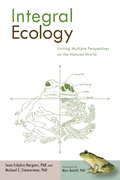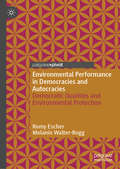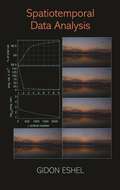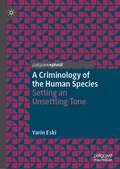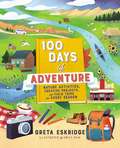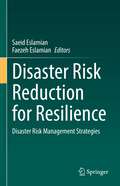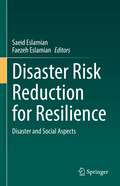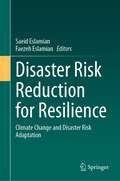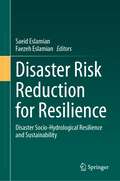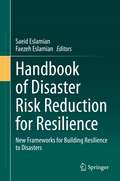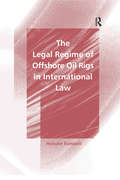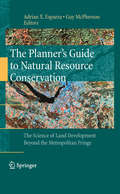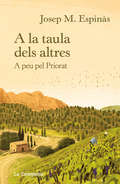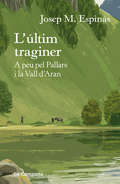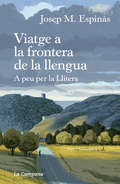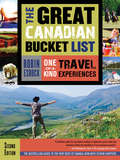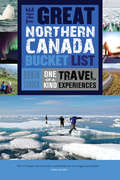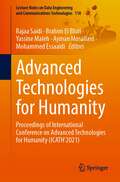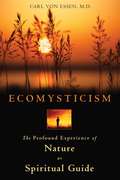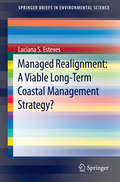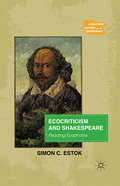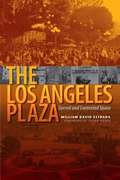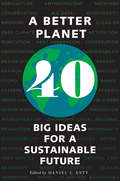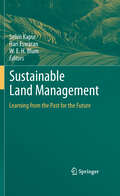- Table View
- List View
Integral Ecology: Uniting Multiple Perspectives on the Natural World
by Sean Esbjorn-Hargens Marc Bekoff Michael E. ZimmermanToday there is a bewildering diversity of views on ecology and the natural environment. With more than two hundred distinct and valuable perspectives on the natural world--and with scientists, economists, ethicists, activists, philosophers, and others often taking completely different stances on the issues--how can we come to agreement to solve our toughest environmental problems?In response to this pressing need, Integral Ecology unites valuable insights from multiple perspectives into a comprehensive theoretical framework--one that can be put to use right now. The framework is based on Integral Theory, as well as Ken Wilber's AQAL model, and is the result of over a decade of research exploring the myriad perspectives on ecology available to us today and their respective methodologies.Dozens of real-life applications and examples of this framework currently in use are examined, including three in-depth case studies: work with marine fisheries in Hawai'i, strategies of eco-activists to protect Canada's Great Bear Rainforest, and a study of community development in El Salvador. In addition, eighteen personal practices of transformation are provided for you to increase your own integral ecological awareness. Integral Ecology provides the most sophisticated application and extension of Integral Theory available today, and as such it serves as a template for any truly integral effort.
Environmental Performance in Democracies and Autocracies: Democratic Qualities and Environmental Protection
by Romy Escher Melanie Walter-RoggThere are considerable differences in environmental performance and outcomes across both democracies and autocracies, but there is little understanding of how levels of democracy and autocracy influence environmental performance. This book examines whether analysing the effects of individual democratic features separately can contribute to a better understanding of cross-national variance in environmental performance. The authors show that levels of social equality in particular, as well as the strength of local and regional democracy, contribute significantly to explaining cross-national variation in environmental performance. On the other hand, a high level of political corruption affects a country’s ability to adopt and implement environmental policies effectively. In exploring the inter-relationship between democratic qualities, political corruption, and environmental performance, this book presents policymakers and political theorists with a clear picture of which aspects of democratic societies are most conducive to producing a better environment.
Spatiotemporal Data Analysis
by Gidon EshelA severe thunderstorm morphs into a tornado that cuts a swath of destruction through Oklahoma. How do we study the storm's mutation into a deadly twister? Avian flu cases are reported in China. How do we characterize the spread of the flu, potentially preventing an epidemic? The way to answer important questions like these is to analyze the spatial and temporal characteristics--origin, rates, and frequencies--of these phenomena. This comprehensive text introduces advanced undergraduate students, graduate students, and researchers to the statistical and algebraic methods used to analyze spatiotemporal data in a range of fields, including climate science, geophysics, ecology, astrophysics, and medicine. Gidon Eshel begins with a concise yet detailed primer on linear algebra, providing readers with the mathematical foundations needed for data analysis. He then fully explains the theory and methods for analyzing spatiotemporal data, guiding readers from the basics to the most advanced applications. This self-contained, practical guide to the analysis of multidimensional data sets features a wealth of real-world examples as well as sample homework exercises and suggested exams.
A Criminology of the Human Species: Setting an Unsettling Tone (Palgrave Studies in Green Criminology)
by Yarin EskiThe book sketches out how the criminological lens could be used in the climate change debate around possible human extinction. It explores the extent to which the human species can be considered deviant in relation to other species of the contemporary biosphere, as humans seem to be the only species on Earth that does not live in natural balance with their environment (anymore). It discusses several unsettling topics in the public debate on climate change, specifically the taboo of how humans may not survive the ongoing climate change. It includes chapters on the Earth’s history of mass-extinctions, the global state of denial including toward the possibility that the human species could go extinct, and it considers humans' future as a deviant, fatal species outside of Earth, in outer-space, possibly on other planets. It puts forward and enriches the critical criminological tradition by conceptualizing and setting an unsettling tone within criminology and criminological research on the human species and our extinction, by daring criminologists (and victimologists) to ponder and seek empirical answers to controversial imaginations and questions about our possible extinction.
100 Days of Adventure: Nature Activities, Creative Projects, and Field Trips for Every Season
by Greta EskridgeTurn off the screen and turn on the creativity as second-generation homeschooling mom Greta Eskridge shares 100 hands-on learning activities for kids that will connect and enrich your family through adventures, small and big.Have a meteor slumber party, attend a symphony concert, take a hike in the rain, preserve colorful fall leaves, and make nettle pesto as children explore a love of nature and venture into the great, wide, real world. From backyard bugs to farmer's market veggies, children will unplug from electronics; explore the world; and learn about nature, art, music, and themselves through STEAM projects and new experiences.100 Days of Adventure will spark curiosity in 6- to 10-year-olds withIndoor and outdoor seasonal activities, projects, experiments, crafts, recipes, and field tripsFree and low-cost activities, with options for different kinds of groups and locationsStep-by-step directions, nature journal prompts, tips, and checklistsBeautiful photos and helpful illustrationsChildren can bond with parents and siblings, learn new skills with individual investigations, or explore with friends in an educational or homeschool group with this full-color activity book. Also included is a note to parents with encouraging start-here guidance on growing a family culture of curiosity and adventure.Whether your family is looking for fun activities for school breaks at home, road trip vacations, or everyday ways to learn together, this collection of interactive educational activities will help your kids get creative, get into nature, and get closer to each other.Don't miss Greta's essential guide for parents on building a connected and loving family through exploration, Adventuring Together: How to Create Connections and Make Lasting Memories with Your Kids.
Disaster Risk Reduction for Resilience: Disaster Risk Management Strategies
by Saeid Eslamian Faezeh EslamianThis book is part of a six-volume series on Disaster Risk Reduction and Resilience. The series aims to fill in gaps in theory and practice in the Sendai Framework, and provides additional resources, methodologies and communication strategies to enhance the plan for action and targets proposed by the Sendai Framework. The series will appeal to a broad range of researchers, academics, students, policy makers and practitioners in engineering, environmental science and geography, geoscience, emergency management, finance, community adaptation, atmospheric science and information technology. This volume offers the international guidelines and global standards for resilient disaster risk reduction and lessons learned from disasters, particularly the COVID-19 and Cholera pandemics. A resilient health system and an effective disaster risk management Index are then suggested. The book further emphasizes urban resilience strategies with local authorities, adaptation strategies for urban heat at regional, city and local scales, and lessons from community-level interventions. Also addressed are coastal erosion, displacement and resettlement strategies. Land use planning and green infrastructure are suggested as tools for natural hazards reduction. Human security in times of climate change and urban heat at regional, city and local scales is discussed for an integrated action, with case studies based in Manila, Burkina Faso, Chad, Mauritania, Niger, Senegal, Nigeria, India, Spain, and Ghana. Structure design for cascading disasters resulting from mining and flooding is presented and sustainable smart city planning using spatial data is recommended.
Disaster Risk Reduction for Resilience: Disaster and Social Aspects
by Saeid Eslamian Faezeh EslamianThis book is part of a six-volume series on Disaster Risk Reduction and Resilience. The series aims to fill in gaps in theory and practice in the Sendai Framework and provides additional resources, methodologies, and communication strategies to enhance the plan for action and targets proposed by the Sendai Framework. The series will appeal to a broad range of researchers, academics, students, policy makers, and practitioners in engineering, environmental science, geography, geoscience, emergency management, finance, community adaptation, atmospheric science and information technology.This volume provides a holistic approach to developing disaster risk reduction strategies and policies, exploring the most effective ways to integrate physical and social science aspects of hazard resilience to better inform local populations. This risk-based approach to community resilience development is used to craft a collaborative system for crisis management, and allows for the implementation of nationally determined contributions (NDCs) through social innovation and community engagement to enhance community emergency response support and preparedness. Readers will also learn about education of disaster risk reduction, human health risk assessment, gendered perspectives in disaster response, recovery, and disaster management legislation.
Disaster Risk Reduction for Resilience: Climate Change and Disaster Risk Adaptation
by Saeid Eslamian Faezeh EslamianThis book is part of a six-volume series on Disaster Risk Reduction and Resilience. The series aims to fill in gaps in theory and practice in the Sendai Framework, and provides additional resources, methodologies, and communication strategies to enhance the plan for action and targets proposed by the Sendai Framework. The series will appeal to a broad range of researchers, academics, students, policy makers, and practitioners in engineering, environmental science and geography, geoscience, emergency management, finance, community adaptation, atmospheric science, and information technology.This volume offers indigenous approaches to disaster risk reduction, community sustainability and climate change resilience, as well as agro-ecological innovations for improving resilience to climate change. The focus is on adaptation strategies for sustainable terrestrial and marine ecosystems to reduce the impacts of anthropogenic factors that exacerbate disaster risk, including hydro-meteorological services for climate resilience, food security measures in agriculture and livestock, flood mitigation plans, and increased climate change education and awareness. The book concludes with three case studies in Africa detailing the impacts of strengthened climate change resilience measures, adaptive social protections, and improved water availability through hydro-electric technologies.
Disaster Risk Reduction for Resilience: Disaster Socio-Hydrological Resilience and Sustainability
by Saeid Eslamian Faezeh EslamianThis book is part of a six-volume series on Disaster Risk Reduction and Resilience. The series aims to fill in gaps in theory and practice in the Sendai Framework, and provides additional resources, methodologies and communication strategies to enhance the plan for action and targets proposed by the Sendai Framework. The series will appeal to a broad range of researchers, academics, students, policy makers and practitioners in engineering, environmental science and geography, geoscience, emergency management, finance, community adaptation, atmospheric science and information technology.This volume discusses the implementation of socio-hydrological resilience measures to curb the impacts on vulnerable communities of hydrologic diasters such as coastal floods, drought, water scarcity, and thunderstorms. The book provides a framework for sustainable hydrology-community interactions to inform local communities about the best practices to achieve hydrological resilience, and to implement resilient water infrastructure. Hydrological influences on the resilience of a region are comprehensively surveyed, and a "green economy strategy" is described and recommended for achieving climatic and hydrological sustainability.
Handbook of Disaster Risk Reduction for Resilience: New Frameworks for Building Resilience to Disasters
by Saeid Eslamian Faezeh EslamianThis book is part of a six-volume series on Disaster Risk Reduction and Resilience. The series aims to fill in gaps in theory and practice in the Sendai Framework, and provides additional resources, methodologies and communication strategies to enhance the plan for action and targets proposed by the Sendai Framework. The series will appeal to a broad range of researchers, academics, students, policy makers and practitioners in engineering, environmental science and geography, geoscience, emergency management, finance, community adaptation, atmospheric science and information technology. This volume discusses how to measure and build disaster resilience at society’s capacity, drawing upon individual, institutional and collective resources to cope with and adapt to the demands and challenges of natural disaster occurrences. The book will serve as a guide, outlining the key indicators of disaster resilience in urban and rural settings, and the resources and strategies needed to build resilient communities in accordance with the targets of the Sendai Framework. Readers will learn about multi-risk reduction approaches using computational methods, data mining techniques, and System Thinking at various scales, as well as institutional and infrastructure resilience strategies based on several case studies.
The Legal Regime of Offshore Oil Rigs in International Law
by Hossein EsmaeiliThis book reviews and examines the relevant portions of all international treaties, cases and the national law and practice of states, in relation to international aspects of offshore oil rigs. By doing so, it offers an understanding of the legal regime surrounding oil rigs and formulates an international law framework. It investigates the issues under consideration by analyzing provisions of international law pertaining to all aspects of oil rigs, as well as international treaties and their travaux preparatoires. It also examines the national legislation of major offshore oil and gas producers and defines a framework of customary international entities such as the OSPAR and the petroleum industries of certain major offshore oil producers. Based upon the book's findings, it is clear that in spite of their increasing importance, offshore oil installations are subject to fragmentary and vague legal rules under international law.
The Planner’s Guide to Natural Resource Conservation:
by Adrian X. Esparza Guy McphersonMuch of the country's recent population growth is situated in exurban areas. By many accounts exurbanization has become the dominant pattern of land development in the country and there is no indication it will slow in the foreseeable future (Theobald 2005; Brown et al. 2005; Glennon and Kretser 2005). By definition, exurban development takes place beyond the metropolitan fringe, often in rural and remote areas. The development of new exurban communities is a growing trend, especially in the West. In this case, developers and homebuilders seek large tracts of land, up to thousands of acres, in rural areas (typically within 50 miles of a large city) where they plan entire communities consisting of commercial, retail and residential land uses. Recreational amenities such as golf courses and hiking/biking trails are often included in these master-planned developments. Our philosophy is reflected in the book's two objectives. First, we seek to document the extent and impacts of exurban development across the country. At issue is demonstrating why planners and the public-at-large should be concerned about exurbanization. We will demonstrate that even though exurbanization favors amenity rich regions, it affects all areas of the country through the loss of agricultural and grazing lands, impacts to watersheds and land modification. A summary of environmental impacts is presented, including the loss of wildlands and agricultural productivity, land modification, soil erosion, impacts to terrestrial hydrologic systems, the loss of biodiversity, nonnative and endangered species and other topics. Our second aim is to provide readers from diverse (nonscientific) backgrounds with a working knowledge of how and why exurbanization impacts environmental systems. This is accomplished by working closely to ensure contributors follow a specific outline for each chapter. First, contributors will spell out fundamental concepts, principles and processes that apply to their area of expertise (e.g., riparian areas). Contributors will move beyond a cursory understanding of ecological processes without overwhelming readers with the dense material found typically in specialized texts. For this reason, visuals and other support materials will be integral to each chapter. We have chosen contributors carefully based on their record as research scientists and acumen as educators. Second, once the mechanics have been laid out, authors will explain how and why land development in nearby areas influences ecosystems. Issues of interdependency, modification and adaptation, spatial scale and varying time horizons will be featured. Third, contributors will weigh in on the pros and cons of various land-development schemes. Fourth, authors will share their thinking on the merits of conservation devices such as wildlife corridors, open-space requirements and watershed management districts. Finally, each chapter will conclude by identifying pitfalls to avoid and highlighting "best practices" that will mitigate environmental problems or avoid them altogether. In sum, after completing each chapter, readers should have a firm grasp of relevant concepts and processes, an understanding of current research and know how to apply science to land-use decisions.
A la taula dels altres: A peu pel Priorat
by Josep Maria EspinàsEspinàs comparteix l'experiència de caminar per un Priorat en temps de verema, amb costums i personatges que avui semblen inventats. El 1957 Josep M. Espinàs va conèixer un Priorat del qual, amb l'excepció del vi, se'n tenien molt poques notícies, en una època en què encara es traginava el raïm en rucs i s'anava a buscar l'aigua a la font amb àmfores. En el llibre A la taula dels altres, l'escriptor camina per aquesta comarca durant la verema i passeja per uns pobles on un foraster és una raresa. Espinàs esmorza i conversa amb la gent que troba a les vinyes i coneix una sèrie de personatges curiosos que, a través de la mirada de l'escriptor, hi apareixen molt ben retratats. El que era una crònica de viatge, fidel a la realitat, ara s'ha convertit en una narració que reviu un món que forma part del nostre passat.
L'últim traginer: A peu pel Pallars i la Vall d'Aran
by Josep Maria EspinàsEspinàs converteix l'experiència de la caminada en una crònica viva en la qual el lector s'aventura amb l'escriptor per camins desconeguts del Pallars i la Vall d'Aran. L'últim traginer ens transporta a un temps en què el Pallars i la Vall Aran no tenien estacions d'esquí, els guàrdies civils anaven amb bicicleta i la centraleta de telèfons de Salardú la feia funcionar, manualment, una noia en un racó de menjador d'una antiga fonda. El lector s'aventura amb l'escriptor pels camins i les valls d'aquestes contrades, en una crònica que reviu un món rural perdut i nostàlgic de mitjan anys cinquanta. Josep M. Espinàs, a través d'aquesta crònica del 1956, reviu uns fets, uns personatges i un paisatge que avui ja formen part del passat, però que l'autor manté vius per sempre amb el seu testimoni de narració viva.
Viatge a la frontera de la llengua: A peu per la Llitera
by Josep Maria EspinàsOn és exactament la Llitera? Com s'hi viu? Quin català es parla en aquesta comarca de l'Aragó? La passió per caminar i descobrir ha dut a Josep M. Espinàs, aquesta vegada, a una terra plena d'interrogants per a molta gent. On és exactament la Llitera? Quin català es parla en aquesta comarca de l'Aragó? La passió per caminar i descobrir va dur Josep M. Espinàs a una terra de pas plena d'interrogants per a molta gent. El 1990, caminant per la Llitera amb sol i amb tempestes, amb totes les sorpreses d'un viatge com aquest, Espinàs converteix l'experiència d'anar a peu en una narració viva, en una crònica que es llegeix com si el lector també s'aventurés amb l'escriptor per camins desconeguts. "Tota la Llitera a peu?, això no ho ha fet mai ningú!", li van dir els lliterans. Viatge a la frontera de la llengua és una obra excepcional en la literatura de viatges de Josep M. Espinàs, tant per l'escenari com pels fets que s'hi narren. Amb aquest llibre, l'autor aporta un testimoni directe i apassionat dels pobles de la comarca.
The Great Canadian Bucket List: One-of-a-Kind Travel Experiences
by Robin EsrockA National Bestseller! Fully revised with new chapters and fascinating destinations to explore, renowned travel writer Robin Esrock guides you to Canada’s most incredible experiences. Having visited more than 100 countries on 7 continents, Robin Esrock has built a career chasing the extraordinary. His bestselling Bucket List books feature experiences that are entirely unique, instantly memorable, wholly inspirational, and available to all. Celebrating his adopted home of Canada, Robin journeys to every province and territory to reveal the remarkable activities and destinations that are unique to the True North strong and free. Get ready to: Cross the mythical Northwest Passage Cycle across Prince Edward Island Float on Canada’s very own Dead Sea Feel the hot breath of a wild polar bear Cave bash along Quebec’s Magdalen Islands Sail among whales in the “Galapagos of the North” Taste Canada’s best poutine, smoked meat, and fish and chips Raft a tidal wave, roll your car uphill, camp in the Arctic and much more! Robin packs each chapter with colourful descriptions, unforgettable characters, quirky trivia, and eye-popping photography. With more than 70 exciting new experiences, the new edition unlocks an extensive online companion where you’ll find videos, galleries, maps, reading guides, and all the practical information you’ll need to follow in Robin’s footsteps.
The Great Northern Canada Bucket List: One-of-a-Kind Travel Experiences
by Robin EsrockFollowing a car accident in Vancouver, Robin Esrock set off on a worldwide expedition to tick off the many items on his personal bucket list. More than one hundred countries later, he realized that missing among his extraordinary adventures was his adopted home: Canada. Welcome to Robin’s acclaimed journey to discover the bucket-list-worthy experiences that define a nation. Travelling across Canada’s vast northern territories, Robin was delighted to find unique adventures for both visitors and locals alike. Through his discovery of nature, culture, history, food, and a few quirky tidbits of Canadiana, Robin's personal quest to tick off the exceptional destinations and activities of the North pack in enough adventure for a lifetime. Accompanied by recommendations, and with bonus content available online, discover one-of-a-kind experiences in Yukon, Northwest Territories, and Nunavut. Categorized by territory, The Great Northern Canada Bucket List will give you a first-hand perspective on: Camping in the High Arctic. Crossing the Northwest Passage. Watching wild beluga whales play at your feet. Tasting muktuk and Arctic char. Dogsledding with a Yukon Quest legend. Flying with Buffalo Air. Swallowing the Sourtoe Cocktail. ... and much more!
Advanced Technologies for Humanity: Proceedings of International Conference on Advanced Technologies for Humanity (ICATH'2021) (Lecture Notes on Data Engineering and Communications Technologies #110)
by Mohammed Essaaidi Yassine Maleh Rajaa Saidi Brahim El Bhiri Ayman MosallamThis book gathers the proceedings of the International Conference on Advanced Technologies for Humanity (ICATH’2021), held on November 26-27, 2021, in INSEA, Rabat, Morocco. ICATH’2021 was jointly co-organized by the National Institute of Statistics and Applied Economics (INSEA) in collaboration with the Moroccan School of Engineering Sciences (EMSI), the Hassan II Institute of Agronomy and Veterinary Medicine (IAV-Hassan II), the National Institute of Posts and Telecommunications (INPT), the National School of Mineral Industry (ENSMR), the Faculty of Sciences of Rabat (UM5-FSR), the National School of Applied Sciences of Kenitra (ENSAK) and the Future University in Egypt (FUE).ICATH’2021 was devoted to practical models and industrial applications related to advanced technologies for Humanity. It was considered as a meeting point for researchers and practitioners to enable the implementation of advanced information technologies into various industries. This book is helpful for PhD students as well as researchers.The 48 full papers were carefully reviewed and selected from 105 submissions. The papers presented in the volume are organized in topical sections on synergies between (i) smart and sustainable cities, (ii) communication systems, signal and image processing for humanity, (iii) cybersecurity, database and language processing for human applications, (iV) renewable and sustainable energies, (V) civil engineering and structures for sustainable constructions, (Vi) materials and smart buildings and (Vii) Industry 4.0 for smart factories.All contributions were subject to a double-blind review. The review process was highly competitive. We had to review 105 submissions from 12 countries. A team of over 100 program committee members and reviewers did this terrific job. Our special thanks go to all of them.
Ecomysticism: The Profound Experience of Nature as Spiritual Guide
by Carl Von EssenExplores the philosophy, science, and spirituality of nature mysticism and its Green calling • Offers a solid bridge between spiritual practice and environmental activism • Reveals how we can heal the environment by renewing our connection to it • Shows how spiritual encounters in nature are healing the Nature Deficit Disorder of our psyches and bodies Many have been struck by a majestic moment in nature--a sole illuminated flower in a shady grove, an owl swooping silently across a wooded path, or an infinitely starry sky--and found themselves in a state of expanded awareness so profound they can feel the interconnectedness of all life. These trance-like moments of clarity, unity, and wonder often incite a call to protect and preserve the earth--to support Nature as she supports us. Termed “nature mysticism,” people from all cultures have described such experiences. However, the ever-increasing urbanization of the world’s population is threatening this ancient connection as well as the earth itself. In Ecomysticism, Carl von Essen explores nature mysticism through the recorded experiences of outdoor enthusiasts as well as scientific studies in biology, psychology, and neuroscience. Citing consciousness scholar William James and a variety of well-known nature lovers such as Ansel Adams, Henry David Thoreau, and Ralph Waldo Emerson, von Essen shows how the spiritual transcendence from an encounter in nature--like other mystical experiences--is healing the Nature Deficit Disorder of our psyches and bodies, leading to an expansion of our worldview and a clearer understanding of our self and of our natural world. Offering a solid bridge between spiritual practice and environmental activism, von Essen’s spiritual ecology reveals how only through a renewal of humanity’s spiritual connection to nature can we effect true environmental healing.
Our Beautiful, Fragile World: The Nature and Environmental Photographs of Peter Essick
by Peter Essick"Our Beautiful, Fragile World" features a career-spanning look at the images of photojournalist Peter Essick taken while on assignment for "National Geographic" magazine. In this book, Essick showcases a diverse series of photographs from some of the most beautiful natural areas in the world and documents major contemporary environmental issues, such as climate change and nuclear waste. Each photograph is accompanied by commentary on the design process of the image, Essick's personal photographic experiences, and informative highlights from the research he completed for each story. "Our Beautiful, Fragile World" takes the reader on a journey around the globe, from the Oulanka National Park near the Arctic Circle in Finland to the Adelie penguin breeding grounds in Antarctica. "Our Beautiful, Fragile World" will interest photographers of all skill levels. It carries an important message about conservation, and the photographs provide a compelling look at our environment that will resonate with people of all ages who care about the state of the natural world. Foreword by Jean-Michel Cousteau.
Managed Realignment: A Viable Long-Term Coastal Management Strategy?
by Luciana S. EstevesManaged realignment has been a preferred coastal management strategy in England in the 21st century and has also been increasingly implemented elsewhere. Climate change and environmental and financial concerns have led to a shift from the traditional 'hold-the-line' approach of coastal protection towards more flexible soft engineering options. Managed realignment is a relatively new soft engineering alternative aiming to provide sustainable flood risk management with added environmental and socio-economic benefits by creating space for coastal habitats to develop more dynamically. The natural adaptive capacity of coastal habitats and the ecosystem services they provide underpin the sustainability of managed realignment. However, many definitions of managed realignment exist and the understanding of what the term actually represents in practice has evolved through time and varies regionally. This book clarifies the definitions and terminology used in the literature and proposes that managed realignment is used as a general term that encompasses the many different methods of implementation worldwide, including: removal, breach and realignment of defences; controlled tidal restoration (which includes regulated tidal exchange and controlled reduced tide); and managed retreat. These methods of implementation are explained and illustrated with examples from around the world. In addition to a general overview of emerging policies and current practices, specific chapters discuss approaches adopted in different locations, including the Netherlands, the UK and Maui (USA). The UK experience is presented from the perspectives of three sectors: the National Trust (a charity organisation that owns 10% of the coastline of England and Wales), the Environment Agency (the organisation responsible for implementing government policy concerning flood and erosion risk) and a private consultant involved in the planning, design and delivery of managed realignment projects. Taking a wider perspective to consider the range of implementation methods, the viability of managed realignment as a long-term coastal management strategy is discussed. Recent national and regional strategies worldwide give managed realignment an increasing role in climate change and flood risk management. Gaining stakeholders and public support is fundamental for the success of emerging coastal management strategies. However, public perception and stakeholders engagement are often cited as a factor limiting the wider uptake of managed realignment. Results from a recent survey are used to benchmark the current thinking about the potential, the performance and the limitations of managed realignment in the UK and elsewhere. Current opinions about managed realignment are often not clearly defined, partly due to many projects being relatively recent. There is a general perception of great potential to provide sustainable flood risk management with added environmental benefits. However, the views of stakeholders are considerably more negative and notably contrast with the views of practitioners and researchers. The only clear and dominant agreement across all groups of respondents is that better understanding about the long-term evolution of sites is needed
Ecocriticism and Shakespeare
by Simon C. EstokThis book offers the term 'ecophobia' as a way of understanding and organizing representations of contempt for the natural world. Estok argues that this vocabulary is both necessary to the developing area of ecocritical studies and for our understandings of the representations of 'Nature' in Shakespeare.
The Los Angeles Plaza
by William David EstradaCity plazas worldwide are centers of cultural expression and artistic display. They are settings for everyday urban life where daily interactions, economic exchanges, and informal conversations occur, thereby creating a socially meaningful place at the core of a city. At the heart of historic Los Angeles, the Plaza represents a quintessential public space where real and imagined narratives overlap and provide as many questions as answers about the development of the city and what it means to be an Angeleno. The author, a social and cultural historian who specializes in nineteenth- and early twentieth-century Los Angeles, is well suited to explore the complex history and modern-day relevance of the Los Angeles Plaza. From its indigenous and colonial origins to the present day, Estrada explores the subject from an interdisciplinary and multiethnic perspective, delving into the pages of local newspapers, diaries and letters, and the personal memories of former and present Plaza residents, in order to examine the spatial and social dimensions of the Plaza over an extended period of time. The author contributes to the growing historiography of Los Angeles by providing a groundbreaking analysis of the original core of the city that covers a long span of time, space, and social relations. He examines the impact of change on the lives of ordinary people in a specific place, and how this change reflects the larger story of the city.
A Better Planet: Forty Big Ideas for a Sustainable Future
by Daniel C. Esty Ingrid C. BurkeA practical, bipartisan call to action from the world’s leading thinkers on the environment and sustainability Sustainability has emerged as a global priority over the past several years. The 2015 Paris Agreement on climate change and the adoption of the seventeen Sustainable Development Goals through the United Nations have highlighted the need to address critical challenges such as the buildup of greenhouse gases in the atmosphere, water shortages, and air pollution. But in the United States, partisan divides, regional disputes, and deep disagreements over core principles have made it nearly impossible to chart a course toward a sustainable future. This timely new book, edited by celebrated scholar Daniel C. Esty, offers fresh thinking and forward-looking solutions from environmental thought leaders across the political spectrum. The book’s forty essays cover such subjects as ecology, environmental justice, Big Data, public health, and climate change, all with an emphasis on sustainability. The book focuses on moving toward sustainability through actionable, bipartisan approaches based on rigorous analytical research.
Sustainable Land Management
by Hari Eswaran Selim Kapur Winfried E.H. BlumSoil quality is threatened by many human-induced activities, but can also be improved by good land management. In the relatively short history of mankind on earth, the landscape and soils of the world have been drastically modified from their "natural " state. Landscapes altered by man's activities are termed "Anthroscapes" which are inextricably linked to culture and history. The challenges for today's scientists are to devise and implement sustainable land management strategies in order to preserve the land for the benefit of future generations. This book is a valuable compendium of the research experiences so far gained in studies of the context and concept of the "Anthroscape" and highlights the potential future contributions of such research to sustainable development.
